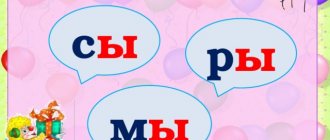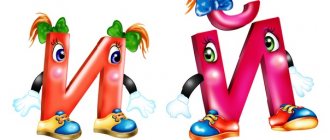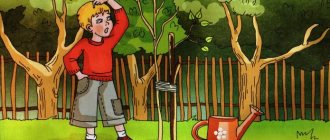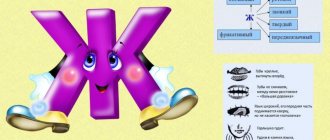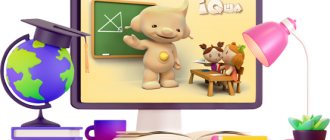Summary of educational activities for preparing for teaching literacy in the senior group on the topic “Sounds [a], [u]. Letters A, U"
author: Gantseva Marina Arkadyevna
Teacher-speech therapist Federal State Budgetary Preschool Educational Institution "Kindergarten No. 568", Yekaterinburg
Summary of educational activities for preparing for teaching literacy in the senior group on the topic “Sounds [a], [u]. Letters A, U"
Summary of educational activities for preparing for teaching literacy in the senior group
on the topic “Sounds [a], [u]. Letters A, U"
The summary was compiled by:
Gantseva M. A. (teacher-speech therapist)
Federal State Budgetary Educational Institution "Kindergarten No. 568", Yekaterinburg
Tasks:
- clarify the concept of “vowel sounds”;
- learn to differentiate the sounds [a], [u];
- learn to highlight the first sound in a word;
- learn to select words with a given initial sound using visual support and without it;
- develop phonemic hearing;
- develop skills in sound analysis and synthesis of syllables, reading syllables (ay, ua);
- fix the graphic image of the letters A, U;
- develop memory;
- cultivate curiosity, interest in sounds and letters;
- cultivate a caring attitude towards things (aids used in class).
Equipment:
- laptop, projector, speakers, presentation; cards for continuous reading of syllables (au, ua); magnetic board, red chips (magnets); letters A, U; pointer; diagram for determining the place of a sound in a word, red chip;
- for children: individual mirrors; diagrams for determining the place of a sound in a word; sound pencil cases (with chips in red, green and blue); notebooks; cards for continuous reading of syllables (au, ua); cash registers; simple pencils, counting sticks (letter set).
GCD move:
- Introductory part. Game "Memorize and repeat"
:
| watermelon – shark – orange pineapple – apricot – Africa album – stork – arch | morning - street - ear Ulya - mind - mustache already - knot - clever |
Articulation gymnastics
. “Window”, “Tube”, “Window - tube”, moving the lips with a “proboscis” to the right and left, “Horse”.
SLIDE No. 2
- Main part:
1) “Sounds [u], [a], we know you!”:
— What sounds did we study? (A, U) Let's remember about them, everything we know.
SLIDE No. 3
- How is Anya crying? (A)
SLIDE No. 4
- How does a wolf howl? (U)
SLIDE No. 5
- Now listen to me and guess who it is: Anya or the wolf? (The speech therapist pronounces the sounds [a], [u] several times, the children guess everything together and individually)
SLIDE No. 6
Clarification of the articulation of sounds [a], [u].
Children tell the snail about the articulation of the sound [u], and Aibolit - about the articulation of the sound [a].
The articulation analysis plan appears gradually in the presentation:
- lips
- teeth
- language
- how the air comes out of the mouth (freely) - a “breeze” flies out (picture)
Guessing sounds from silent articulation.
SLIDE No. 7
- What color are the sounds [a], [u]? In what color castle do the sounds [a], [u] live? (Children choose)
SLIDE No. 8
Characteristics of sounds (vowel sounds). Children tell Dunno.
- What is the sound? (Vowel) Why? (Air comes out of the mouth freely).
- What is the sound? (Vowel) Why? (Air also comes out of the mouth freely).
SLIDE No. 9
2) Game “Name the first sound in the word.”
The speech therapist and children take a diagram to determine the place of a sound in a word, put a red chip in the first window (the sound at the beginning of the word)
Pictures appear on the screen, children name them by highlighting the first sound and clicking on the chip. Children name the first sound (all together and individually).
Pictures: pineapple, stork, duck, bus, iron, fishing rod, shark, oranges, snail, duckling, apricot, street.
3) Didactic game “Guess the word” (based on pictures).
SLIDE No. 10
The speech therapist says: “I will make words. To guess a word, you will need to add the first sound to it - [a] or [y]. Pictures will help you guess the words.” Vocabulary material: ...pelsins, ...tyug, ...bus, ...tenok, ...bricot, ...fabric, ...litka, ...daughter, ...kula, ...faces, ...nanas, ...ist..
4) Physical exercise “A or U?”
The speech therapist pronounces the sounds [a], [u]. Children, if they hear the sound [a], pretend to be a stork; if they hear the sound [u], they pretend to be a Cheburashka with big ears.
SLIDE No. 11
— Guys, let's talk about the letter U.
SLIDE No. 12
5) Letter U.
- Showing a letter.
- Finding a letter in the cash register.
- “How many elements does the letter U have? What are these elements? What does this letter look like?
- Laying out letters from sticks.
- Game “Right - Wrong” (Children determine whether the letter U is written correctly)
SLIDE No. 13
- Drawing a letter in the air (On the screen there is a slide with animation - a snail is crawling, helping to correctly draw the letter U in the air).
SLIDE No. 14
- Game “Identify the sound U”. Children name the pictures that appear on the letter U, emphasizing the sound [u]. Perform finger exercises:
- “Fishing rod” - show the index finger of the right hand (the other fingers are clenched) and rotate the thumb of the left hand.
- “Snail” - first depict a snail with one hand (show the index and middle fingers - “horns”), move the hand along the table (“the snail is crawling”), then with the other hand.
- “Iron” - depict an iron (put one hand palm down on the table, the other hand on top, “iron”).
- “Duck” - show “beaks” with hands.
SLIDE No. 15
6) Game “Decorate the letter U”
. Children take turns naming words with the sound [y] at the beginning of the word. Each child says a word, and flowers appear on the screen (on the letter U).
SLIDE No. 16
— We remembered everything we know about the letter U. Now let's talk about the letter A.
Letter A - first letter a
alphabet (Children notice that the word “alphabet” begins with the sound [a].
7) Letter A.
- Showing a letter.
- Guys, find the letters A on this slide (the speech therapist calls one child to the board, he shows the letters with a pointer: A, a)
- “How many elements does the letter A have? What are these elements?
SLIDE No. 17
- Laying out letters from sticks.
SLIDE No. 18
- Finding a letter in the cash register.
- What does this letter look like?
SLIDE No. 19
- Drawing a letter in the air (On the screen there is a slide with animation - watermelons are moving, helping to correctly draw the letter A in the air).
SLIDE No. 20
 Game “Decorate the letter A”
Game “Decorate the letter A”
. Children take turns naming words with the sound [a] at the beginning of the word. Each child says a word, and flowers appear on the screen (on the letter A).
SLIDE No. 21
9)
Analysis and synthesis of the syllable AU.
The speech therapist shows a picture of Uli (Ulyana).
— Ulya went into the forest. There were a lot of mushrooms in the forest. While picking mushrooms, she went far into the forest and did not notice how she lost her way. Ole became scared. She remembered a short but very necessary word. If you shout, they will hear you and come to your aid. What word is this? (Aw!)
Children slowly pronounce the “word” AU in chorus and in rows.
- Name the first sound in the word Au (A). What is the sound? (vowel). It is indicated by a red chip (Children place the red chip on the table, and the speech therapist on the magnetic board).
- Name the second sound in the word Au (U). What is the sound? (vowel). Label it.
- The first sound is [a]. The second sound is [u]. What happened? (AU) Let’s “read” the word. I lead with a pointer, and you slowly sing each sound in the word (AU).
- Now let’s designate the sounds with letters. Let's read the word (using a card for continuous reading of the syllable AU).
SLIDE No. 22
10) Analysis and synthesis of the syllable UA
.
The speech therapist shows a picture of a crying child.
— The baby cries: “Wow!”
Children slowly pronounce the word UA in chorus and in rows.
The syllable UA is parsed similarly.
SLIDE No. 23
11) Typing syllables
AU, UA.
SLIDE No. 24 with the inscription “Well done!”
- The result of GCD. Reflection.
- Name words with the sound A. Name words with the sound U.
Summary of educational activities for preparing for teaching literacy in the senior group on the topic “Sounds [a], [u]. Letters A, U"
Summary of the lesson “Sound and letter A”. Lesson on generalization and systematization of knowledge
Topic: sound and letter A.
Lesson type: lesson of generalization and systematization of knowledge.
Goal: to systematize students’ knowledge about the vowel sound and the letter A.
Educational: - Continue to teach how to isolate the vowel sound [A] and designate it with a letter.
Corrective and developmental: - Form finger and articulatory motor skills - Develop phonemic perception and representation. — Form sound-syllable analysis and synthesis. — Continue to work on developing kinesthetic sensations. — Correct thinking based on practicing the operation of analysis and synthesis. — Develop the perception of shape by working with geometric shapes. — Use health-saving actions to maintain performance and expand the functional capabilities of the students’ body (dance of vowels, physical exercises, alternation of various types of activities). — Correct attention based on the formation of the ability to distribute.
Correctional and educational: - To develop the ability to understand and accept an educational task posed in verbal form; — Continue to learn how to answer questions during the course of study with adequate use of the learned terminology. — Develop the ability to actively comprehend the material covered.
Equipment: Demonstration material: PC, PP presentation. Handouts: Mirrors, match sticks, homework cards.
Progress of the lesson:
1. Organizational moment The one who recognizes the geometric shapes will sit down.
2. Articulation gymnastics Let's prepare our tongues for work.
3. Finger gymnastics Work with sticks. Laying out figures according to the pattern. Clarification of the name.
4. Work in a notebook in a square Sketching an oval. Hatching the oval from left to right.
5. Repetition of what has been covered Vowel sounds - they sing, dance, do not meet obstacles. Those who agree stumble upon everything, they stumble over everything. Consonants encounter obstacles in the form of lips, teeth, and tongue.
6. Guessing the topic of the lesson. Pronunciation. Proof. Dance. Sound dance: the child stands, holds his hands in front of him in the shape of a wide oval.
7. Working with the articulatory profile Determining the position of the lips, teeth, tongue, and the functioning of the vocal cords when pronouncing a sound. Conclusion: The sound is a vowel.
8. Work with signal cards and in notebooks. Search for the sound [A] in words. If there is [A] in the word - a card with a + sign, if not - with a sign - Orally: army, cat, fish, shower, mushroom, bull, March. In writing: table, sled, hole, scales, smoke, roof, hand.
9. Listening to an audio recording about the sound and letter A. Recording the topic of the lesson.
10. Aunt Owl’s story about the letter A Finding out which words you remember. Clarification of the lexical meaning of these words.
11. Reading forward and backward syllables (choral, in turn) Writing any two syllables in a notebook. We write down the letters of vowel sounds with a pen with red ink.
12. Phys. pause o/r Hammer-hamster hamster (make movements according to the text) Striped flank. The hamster gets up early, washes his cheeks, rubs his neck. Khomka sweeps the hut and goes out to exercise. One, two, three, four, five, Khomka wants to become strong.
13. Working with pictures from the monitor screen. (At the board and in the notebook). Recognition of objects. Recording the names of objects with pronunciation on the board and in a notebook. The letters of vowel sounds are in red. Division into syllables. Repetition of the rule: the number of vowels in a word, the number of syllables.
14. Lesson summary
Presentation for the lesson notes “Sound and letter A”
| The presentation on slide 20 has a link to the video below. You can download the original presentation file. |
Video for lesson notes “Sound and letter A”
Also on topic:
logoped18.ru
